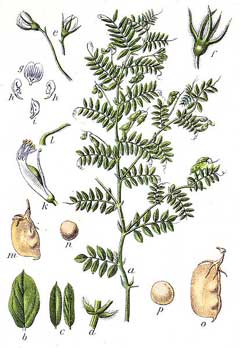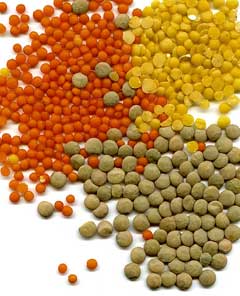 |
|
http://commons.wikimedia.org/wiki/File:Lens_culinaris_Sturm8.jpg |
 |
|
Translate this page:
Summary
Physical Characteristics

 Lens culinaris is a ANNUAL growing to 0.5 m (1ft 8in).
Lens culinaris is a ANNUAL growing to 0.5 m (1ft 8in).
It is not frost tender. The species is hermaphrodite (has both male and female organs) and is pollinated by Cleistogomy (self-pollinating without flowers ever opening). The plant is self-fertile.
It can fix Nitrogen.
Suitable for: light (sandy), medium (loamy) and heavy (clay) soils, prefers well-drained soil and can grow in nutritionally poor soil. Suitable pH: mildly acid, neutral and basic (mildly alkaline) soils. It cannot grow in the shade. It prefers dry or moist soil.
UK Hardiness Map
US Hardiness Map
Synonyms
L. esculenta. Moench.
Plant Habitats
Cultivated Beds;
Edible Uses
Edible Parts: Seed Seedpod
Edible Uses:
Seed - cooked or sprouted and eaten raw[1]. A very nutritious food[171, 177], the seeds can be cooked on their own or added to soups, stews etc[183]. The seed can be soaked for 12 hours in warm water and then allowed to sprout for about 5 days[244]. They have a crunchy, fresh flavour[244]. Lentils are more digestible than many legumes[K]. The dried seed can also be ground into a powder and used with cereal flours in making bread etc[183], this greatly enhances the value of the protein in the bread. The seed stores better if it is left in its husk[200]. Young seedpods - used fresh or cooked like green beans[61, 177, 183].
References More on Edible Uses
Medicinal Uses
Plants For A Future can not take any responsibility for any adverse effects from the use of plants. Always seek advice from a professional before using a plant medicinally.
Laxative Poultice
The seeds are mucilaginous and laxative[240]. They are considered to be useful in the treatment of constipation and other intestinal affections[240]. Made into a paste, they are a useful cleansing application in foul and indolent ulcers[240].
References More on Medicinal Uses
The Bookshop: Edible Plant Books
Our Latest books on Perennial Plants For Food Forests and Permaculture Gardens in paperback or digital formats.

Edible Tropical Plants
Food Forest Plants for Hotter Conditions: 250+ Plants For Tropical Food Forests & Permaculture Gardens.
More

Edible Temperate Plants
Plants for Your Food Forest: 500 Plants for Temperate Food Forests & Permaculture Gardens.
More

More Books
PFAF have eight books available in paperback and digital formats. Browse the shop for more information.
Shop Now
Other Uses
Fuel Green manure
Agroforestry Uses:
The plant can be used as a green manure[418
].
Lentil is mainly grown as a sole crop, but sometimes mixed with other crops, e.g. in India with barley, mustard or castor[299
]. Other Uses:
The seeds are a source of starch for the textile and printing industries[310
, 418
].
The plant remains, after the seed has been harvested, can be used as a fuel[299
].
Special Uses
Food Forest Nitrogen Fixer
References More on Other Uses
Cultivation details
An easily grown plant[K], it prefers a sandy soil in a warm sunny sheltered position[27, 37, 200]. Another report says that it does best on clay[37]. It produces most seed when grown on poorer soils[37]. Lentils are widely cultivated in warm temperate and tropical zones for their edible and very nutritious seed, there are many named varieties[183]. The plants are much hardier than is commonly supposed and many of these varieties can succeed in Britain, particularly in warm summers. There is at least one, called 'WH2040', that can withstand temperatures as low as -23°c in the seedling stage[200]. 'Chilean' is a low-growing plant that can be grown in the winter in areas where winter vegetables can be grown[183]. 'HarLen' tolerates temperatures down to -10°c and performs very well in gardens[183]. The plants take the same time as peas to mature, so lentils are a potential commercial crop for Britain[141]. Yields of up to 2 tonnes per hectare are possible[200]. The main problem with growing them as a commercial crop is that they are produced by using cheap labour in many countries which makes it very difficult for British farmers to compete on prices. However, this does not preclude their being grown in the garden and allotment. Lentils are also beneficial to grow as part of a rotation on the farm or garden. They have a symbiotic relationship with certain soil bacteria, these bacteria form nodules on the roots and fix atmospheric nitrogen. Some of this nitrogen is utilized by the growing plant but some can also be used by other plants growing nearby and, if the roots are left in the ground when the seeds are harvested, this will provide a source of nitrogen for the next crop[200].
References Carbon Farming Information and Carbon Sequestration Information
Temperature Converter
Type a value in the Celsius field to convert the value to Fahrenheit:
Fahrenheit:
The PFAF Bookshop
Plants For A Future have a number of books available in paperback and digital form. Book titles include Edible Plants, Edible Perennials, Edible Trees,Edible Shrubs, Woodland Gardening, and Temperate Food Forest Plants. Our new book is Food Forest Plants For Hotter Conditions (Tropical and Sub-Tropical).
Shop Now
Plant Propagation
Seed - sow early April in situ[1]. Some cultivars are probably suitable for sowing outdoors in the autumn, at least in the milder parts of the country[200].
Other Names
If available other names are mentioned here
Aoi mame, Bagali, Bing dou, Chanangi, Chirisanagalu, Kacang koro, Kacang serinding, Kursam bulle pullie,Lente, Lenticchia, Lentilha, Lentille, Lentja,Linse, Malka masur, Masar, Masser, Masur, Masuri, Masurmoha, Masuro, Misurpappu, Musri, Patani, Pe ni, Pothundhambala, Red Dahl, Sai min dou, Thua daeng, Thua raatcha maat, adas, adas msallam, bing dou, chanam payar, dhal|parippu, gram, lenteja, lenticchia, lentil, lentilha, lentille, lentille comestible, lentillon, lins, linse, masara, masoor, masoor paruppu, masooralu, massora, masura, masur, masura bele, masura pappu, masuri, masura (seed), pittabhe?aja, supya, vattupparupu.
Native Range
TEMPERATE ASIA: Afghanistan (east), Cyprus, Iran, Iraq, Israel, Jordan, Lebanon, Syria, Turkey, Azerbaijan, Georgia, Kazakhstan (south), Tajikistan, Turkmenistan, Uzbekistan TROPICAL ASIA: Pakistan (northwest) EUROPE: Greece
Weed Potential
Right plant wrong place. We are currently updating this section.
Please note that a plant may be invasive in one area but may not in your area so it's worth checking.
Conservation Status
IUCN Red List of Threatened Plants Status : This taxon has not yet been assessed

Growth: S = slow M = medium F = fast. Soil: L = light (sandy) M = medium H = heavy (clay). pH: A = acid N = neutral B = basic (alkaline). Shade: F = full shade S = semi-shade N = no shade. Moisture: D = dry M = Moist We = wet Wa = water.
Now available:
Food Forest Plants for Mediterranean Conditions
350+ Perennial Plants For Mediterranean and Drier Food Forests and Permaculture Gardens.
[Paperback and eBook]
This is the third in Plants For A Future's series of plant guides for food forests tailored to
specific climate zones. Following volumes on temperate and tropical ecosystems, this book focuses
on species suited to Mediterranean conditions—regions with hot, dry summers and cool, wet winters,
often facing the added challenge of climate change.
Read More
Expert comment
Author
Medik.
Botanical References
200
Links / References
For a list of references used on this page please go here
A special thanks to Ken Fern for some of the information used on this page.
Readers comment